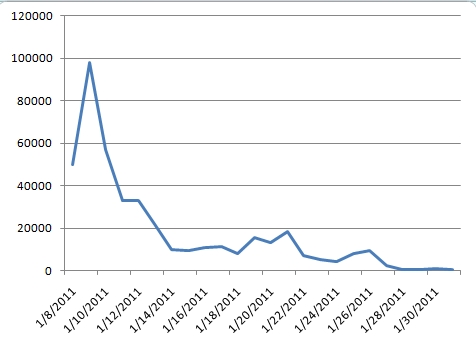
The Language of Threat in Our Political Discourse
G. R. Boynton
Glenn W. Richardson
The threat was manifest:
And on January 8, 2011 while Representative Giffords was meeting constituents in a public space a gunman opened fire killing 6 and wounding 13. Representative Giffords was shot in the head, and while she did not die her recovery was long. This is not the first attempted political assassination in our history. The best known are Lincoln, the Kennedy brothers, Martin Luther King, and Ronald Reagan. But there were two ways this event was different from its predecessors.
This is the first attempted political assassination in the U.S. in the new social media communication era. Twitter and Facebook allow persons to express their thoughts and concerns publicly in a way that has not been possible before. And they were very busy doing that.
 |
| Figure 1. Twitter messages per day containing Giffords |
Collecting Twitter messages that included Giffords name did not start until several hours after the shooting. The 50,000 messages collected on January 8 gives a substantial underestimate of the volume of messages about Giffords that day. There were 98,000 messages the second day, 57,000 the third day, 33,000 the fourth and fifth days, and it declined from there. Between January 8 and the end of the month there were more than 430,000 messages containing Giffords' name.We have never had a record of personal concern like this to examine.
The event is also unusual in having a leading political figure who could be associated with the threat -- Sarah Palin. She had affixed the target to the map of Representative Giffords' district, it was her slogan, and she supported Representative Giffords' opponent. Understanding that association was another facet of the communication about this event. The messages are rife with claims about what should and should not be considered threat and what consequence one should attribute to the threat. Here we have a massive public discussion about threat in the rhetoric of political practice.
The focus of the paper is on the communication resources people brought to trying to understand and cope with this political tragedy in which the language of threat played such a prominent role.
Data Collection and Analysis
Seven streams of Twitter messages are used in the paper. The searches for #p2, #teaparty, Palin, terrorism, and 9/11 are ongoing searches. The two streams that were collected specifically for this research were searches for Giffords and blood libel.
The Twitter messages were collected by searching the Twitter data base using Archivist, which is a program running on Windows computers. You give it a search term, such as Giffords, and every five minutes it searches the Twitter data base and adds new messages to the file of messages it has already found. For these searches the program was run twenty-four hours a day. The streams of messages is the complete collection of messages with the exception of an occasional computer glitch which had a trivial impact on the total in the stream. This is the population. Hence, tests of significance that are designed to indicate how similar a sample would be to the population are not relevant.
Twitter will supply at most 1,500 messages per search request. One consequence of that restriction is the difficulty of getting the first messages of a stream that starts suddenly. If you were not 'there' you cannot retrieve messages before the most recent 1,500. In this case the collection of messages containing Giffords does not start until several hours after the shooting. However, the gap in that stream is partially offset by drawing on the five ongoing collections. Those collections were already in operation at the time of the shooting and can be drawn on for an analysis of the first hours.
The analysis is twofold. We look at the streams to see how they increase and decrease in time and how the content changes over time. We also look more specifically at the way the language of threat is used in the messages.
The first hours
It was a few messages the first thirty minutes, and then it burst into an explosion of concern for the member of congress and for what this act meant for our political system. Our collection of Twitter messges did not begin immediately, but these five streams of messages were being collected and they contain 76,000 messages between 11:00 and 3:45 MST on January 8. The messages were collected by searching Twitter for messages containing #p2 or #teaparty or Palin or terrorism or 9/11 at five minute intervals.
| #p2 | 11:07 |
MT @JonJustice: CD8 Congresswoman Gabrielle Giffords has been shot at the Safeway Area closed, no word on condition. #tcot #p2 |
| #teaparty | 11:17 |
Democratic CongressWoman Giffords shot in AZ |
| Palin | 11:25 |
Gabrielle Giffords was on Palin's infamous "target" map: http://usat.ly/e4NSjp |
| terrorism | 11:35 |
Horrified that Gabrielle Giffords was shot. But not surprised something like this has happened |
| 9/11 | 12:29 |
RIP Rep. Giffords. I haven't been this frightened by a news story since 9/11. We need to learn from this. |
Almost immediately there were messages about Giffords being shot. These five were the first messages mentioning the shooting in each stream. Congresswoman Giffords has been shot; no word on condition. CongressWoman Giffords shot in AZ. Horrified Giffords was shot but not suprised. RIP Giffords. The first sentences set the themes for the first hours. In those first hours one-third of the Twitter messages included Giffords' name, but virtually all were about the shooting and its repercussions.
Because of the way we collected messages in the first hours there is less information about Giffords and the others who were shot than might be expected. The messages above were the first messages reporting the shooting. At about 12:00 mst NPR reported that Giffords was dead, and that news was repeated over and over in the communication. Loughner was not identified until 2:00 MST. But the focus was not on who in these streams. Instead it was on how to understand the event. In the #p2, the progressive hashtag, stream the first messages were
Almost immediately the word went out; Giffords was shot was included in 919 Twitter messages. The language became harsher when it became Giffords assassinated. And then the joining of the threat, the shooting and the consequences for American politics.
RT @tcmassie: Rep. Giffords was on #Palin's infamous "target" map: http://usat.ly/e4NSjp Today she was shot in Tuscon. What is the US turning into? #p2
The move immediately is from threat to personal tragedy and then to what politics in the US is becoming.
The stream identified by searching for Palin is full of references to the threat. Crosshairs was mentioned 6927 times. Target was included in 10,566 messages. And don't retreat, reload was in 1886 messages. The conclusion drawn was
RT @mrdaveyd: @mendocoaster Remember Palin's bullseye map? Congreswmn Giffords was on it. thr R real consequences 2 their words & actions?
There are real consequences to their words and actions -- when you expand the Twitter-ese. The conclusion that the people using this language should understand that there are real consequences was mentioned 450 times in this stream and it was mentioned 221 times in the #teaparty stream. The accusatory way to make this point was
RT @markos: If Palin's crosshair effort was excusable, why has her PAC scrubbed her site of that page? #tcot #teaparty #sgp
If, after this shooting, they did not think there was something wrong with what they had done why were they taking down the web pages that carried the target and list of targeted members of congress? The standard phrase was some version of "scrub" that appeared 683 times in the Palin stream and 206 times in the #teaparty stream.
Terrorism has been the most important societal threat since the bombing of the US embassies in Kenya and Tanzania, and became more fully central in the collective psyche with 9/11. The first messages in the stream found by searching for terrorism identify the shooting with terrorism; "this is terrorism" is included in 2897 statements and this is what "terrorism looks like" is included in another 389 messages. Or
RT @DanteAtkins: Gabrielle Giffords was not "shot". She was assassinated in an act of domestic terrorism.
This is domestic terrorism was included in 1128 messages. Then CNN announced that it was not the act of a terrorist, and that unleashed a flood of messages criticizing their understanding of what it takes to be terrorism
CNN: "There is nothing to indicate this is terrorism." NEWS FLASH! Political murderers are terrorists even if they're white #p2
CNN says rep giffords shooting "was not terrorism". translation: shooter was not a muslim. #doublestandards
Several thousand times the point was made that CNN, and the society, were identifying terrorism only with muslims. If he is white it cannot be terrorism. If he is not a muslim it cannot be terrorism.
The stream identified by searching for 9/11 continues this point with "blame all"
RT @davidsirota: Question for conservatives who blame all Muslims for 9/11: Should we blame all conservatives for Giffords attack if attacker is Tea Partier?
Blaming all muslims for 9/11 is as appropriate as blaming all conservatives for the shooting of Giffords if the attacker is a Tea Partier.
In the first hours 76,000 messages were captured. One-third mentioned Giffords. After the first thirty minutes they were virtually all about the shooting. They set the themes that would dominate for the never several days: the language of threat and the consequences that follow when this language becomes the language of politics, and the identification of this language and action with terrorism.
The streams
Three streams of Twitter messages are important for the analysis. They are the stream of messages that contain Giffords, the stream that contains Palin and the stream that was found by searching for blood libel.
Figure 2 plots the number of Twitter messages containing Giffords and Palin by date.
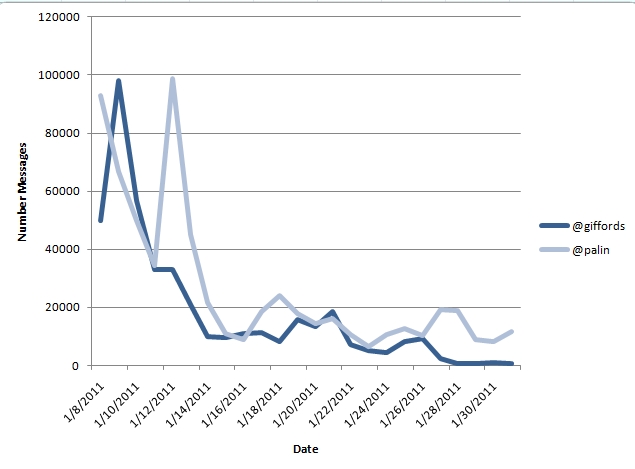 |
The Giffords timeline starts at about 50,000 the eigth of January, climbs to almost 100,000 the nineth, and then declines to five to six hundred by the end of the month. It is 50,000 the first day is because the search did not start for three hours after the shooting. The Palin stream starts at close to 100,000 on the 8th, declines until the 12th when it spikes back up to almost 100,000, and then declines to around 10,000 messages a day by the end of the month. The spike on the 12th results from comment about the video she released that day in which she used blood libel to characterize the action of her critics.
Table 1 Overlap Between Giffords and Palin Streams |
|||
Date |
Giffords |
Giffords-Palin |
Palin |
1/8/2011 |
49806 |
7790 |
92831 |
1/9/2011 |
98069 |
13465 |
66790 |
1/10/2011 |
56884 |
5308 |
49809 |
1/11/2011 |
32976 |
2198 |
34489 |
1/12/2011 |
33043 |
4527 |
98872 |
1/13/2011 |
21098 |
1055 |
45090 |
1/14/2011 |
9862 |
392 |
21625 |
1/15/2011 |
9550 |
206 |
11138 |
1/16/2011 |
10949 |
297 |
8826 |
1/17/2011 |
11306 |
414 |
18401 |
1/18/2011 |
8163 |
245 |
23992 |
1/19/2011 |
15707 |
188 |
17844 |
1/20/2011 |
13329 |
111 |
14506 |
1/21/2011 |
18461 |
86 |
16132 |
1/22/2011 |
7266 |
65 |
10646 |
1/23/2011 |
5125 |
48 |
6423 |
1/24/2011 |
4575 |
136 |
10756 |
1/25/2011 |
8319 |
68 |
12840 |
1/26/2011 |
9296 |
24 |
10151 |
1/27/2011 |
2235 |
41 |
19409 |
1/28/2011 |
612 |
38 |
18792 |
1/29/2011 |
517 |
20 |
8949 |
1/30/2011 |
1118 |
7 |
8180 |
1/31/2011 |
558 |
32 |
11785 |
Some Twitter messages contained both Giffords and Palin. The central column in the table gives the number of overlaps for each day. That shows how the streams converge and diverge. There is a roughly ten percent overlap the first five days. The two streams are increasing and decreasing in somewhat different ways, but the overlap is much more substantial than it becomes at the end of the month. At the end of the month the streams of messages have diverged with little reference to each other.
Table 2. Messages Containing Palin, Blood Libel, and Overlap |
|||
| Date | Palin | Blood Libel | Overlap |
1/12/2011 |
98872 |
16972 |
11232 |
1/13/2011 |
45090 |
8789 |
6018 |
1/14/2011 |
21625 |
2579 |
1712 |
1/15/2011 |
11138 |
1044 |
646 |
1/16/2011 |
8826 |
670 |
376 |
1/17/2011 |
18401 |
2055 |
1624 |
1/18/2011 |
23992 |
2970 |
2649 |
1/19/2011 |
17844 |
795 |
414 |
1/20/2011 |
14506 |
329 |
163 |
1/21/2011 |
16132 |
252 |
176 |
1/22/2011 |
10646 |
125 |
98 |
1/23/2011 |
6423 |
114 |
80 |
1/24/2011 |
10756 |
82 |
60 |
1/25/2011 |
12840 |
119 |
50 |
1/26/2011 |
10151 |
55 |
34 |
1/27/2011 |
19409 |
103 |
37 |
1/28/2011 |
18792 |
45 |
22 |
1/29/2011 |
8949 |
46 |
64 |
1/30/2011 |
8180 |
31 |
13 |
1/31/2011 |
11785 |
23 |
13 |
The blood libel stream does not start until Palin's video on the 12th of January. The first day there were almost 17,000 Twitter messages containing blood libel, and 11,000 contained both Palin and blood libel. The blood libel stream is small relative to the Palin stream, and it decreases much more over time. However, the proportion of messages containing blood libel that also contain Palin does not change even as the number of messages decreases.
Beginning on January 8 the Giffords and Palin streams of Twitter messages overlapped substantially. Over time they diverged, and by the end of the month there was almost no Palin in the Giffords stream and no Giffords in the Palin stream. The blood libel stream was largely a substream of the Palin stream. But blood libel went away over time and the Palin stream continued without reference to either Giffords or blood libel.
The Giffords Stream
Between January 8 and the end of the month 430,000 Twitter messages were found containing the name of Representative Giffords. The first days saw a flood of messages, the flow decreased rather quickly from 100,000 on the 9th to 500 at the end of the month. While our focus is on the language of threat used in these messages we also want to examine the total communication stream in which the language of threat is immersed. How the language of threat fits into and is embodied in communication can be more easily examined using these messages than is often the case.
What were people writing in their Twitter messages? Who are the people identified in messages? What was the 'news' about the event and what happened in the next weeks? And what was the argument about blame for the shooting and what this meant for the rhetoric of American politics?
We developed a coding scheme to help answer the three questions, and we used QDA Miner to code the Twitter messages for analysis. Twitter messages often included more than one of these categories of information. Representative Giffords was shot both identifies the person as a member of the House of Representatives and reports the news that she was shot. So the numbers used here are the number of instances of each of the codes. They are not the number of Twitter messages in which they appear.
At the most general we are interested in who is identified, the news reporting in the messages, and assigning blame for the shooting. At this level of abstraction the occurance of identification and news reporting are almost equal with 438,574 instances of identification and 431,358 instances of news reporting. Assigning blame was just over half of those numbers at 238,620 instances.
Because the total number of messages per day drops quite sharply over time the same is true for the codings. There are many more instances of each of the codes the first few days than is the case toward the end of the month. However, one can look at the relative incidence of the coded materials over time.
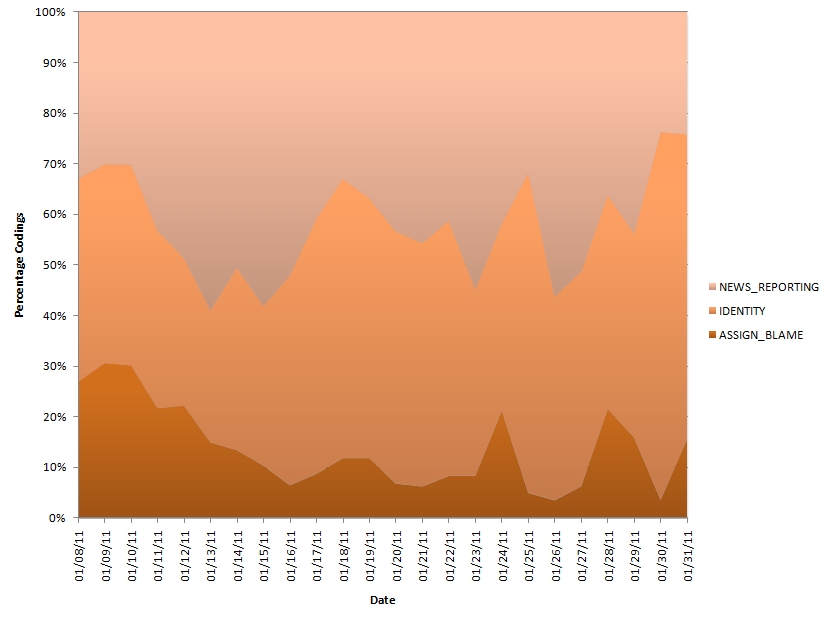 |
| Figure 3. Relative Incidence of Coded Messages |
In Figure 3 the top set is news reporting, the middle set is identity, and the bottom is assign blame. Initially the three are almost equal. Assigning blame is 30% on the second day, identity is 40%, which adds up to 70%, and news reporting is 30%. Over time assigning blame decreases relative to the other two. Identity is somewhat greater than news reporting, and that is more pronounced toward the end of the month than earlier. Over time assigning blame decreases and identity increases as a proportion of the total coding assignments.
Who? The twitter messaging was national and international. Representative Giffords was not a well known figure nationally nor internationally. The other people involved were even less well known. A first act in this kind of situation is to find out who. So tens of thousands of messages identify the people involved in this shooting. Giffords, of course, but in addition her staff person Daniel Hernandez, Mark Kelly, a local judge, the sheriff, Christina and Loughner. On the 9th, for example, Giffords was identified 64,504 times; her first name Gabrielle, Gabby and Gaby were used 34,500 times. That she was a Representative was mentioned 18 thousand times. She is married, and her husband is the astronaut Mark Kelly, which was mentioned 2300 times. On the same day Daniel Hernandez was identified as a member of her congressional staff who had been at the meeting and was killed attempting to save the lives of others; he was mentioned 10,000 times. The judge who was killed was identified 600 times. Christiana was a young girl who was born on 9/11 and had been featured as one of the persons who came into the world on the same day that so many were departing. She was identified 6,700 times on that day. And Loughner/shooter was identified 9,800 times.
The news was twofold. There was news about the shooting, and there was news about Giffords health. The first three days the two were about equally present in the Twitter messages at 20,000 the 8th, 33,000 the 9th and 17,000 the 10th. After that the shooting was 'old news' and it dropped quickly to a very modest number of communications. The news about Giffords health continued to be communicated more frequently. For the entire period the ratio was just over to two to one with total mentions of 239,455 and 110,960. The reporting about Giffords health condition was much more detailed than the news about the shooting. First, she was taken to the hospital. She was reported dead by NPR. She was also reported to be talking to her husband, which was also false. Doctors were mentioned. Her condition was clarified. As she improved her movements were reported. It was a daily report on her condition with new details almost every day.
It is in this context of identifying the persons and news about the shooting and the health condition of Giffords that discussion of how this happened and who was to blame took place. If you were following the Giffords story, as many tens of thousands were, you encountered all of the strands of the story.
As a general category we called it assigning blame, but it was really quite detailed with a highly differentiated set of claims about what and how and who. Who's to blame? First, Palin -- 10,000 on the 8th, 20,000 on the 9th, 7,000 on the 10th, 2,800 on the 11th, and 5,700 on the 12th. After the 12th the number of times blame is assigned to Palin drop to the hundreds and toward the end of the month to the teens. Who's to blame? Second, Loughner, though he never reaches the 'credit' that Palin does. If you compare the totals for the entire period Palin is assigned blame 50,691 times and Loughner only 32,399 times.
Loughner pulled the trigger. What is the language that allocates blame to Palin? It is the threat in her campaign against Democratic candidates in the 2010 election. It is the crosshairs. It is the target. It is the district that is targeted. It is the rhetoric of hate, and violence that is inciting violence. It is the consequence of that rhetoric in political contests that promotes strange individuals to act, to kill. It is the theme that was present in the very first hours that is carried forward in Twitter message after Twitter message. Messages that number in the tens of thousands in only a few days indicting Palin for her political rhetoric.
And then she responds.
Blood Libel
After being pummeled for four days she responded by posting a video on her Facebook page on January 12. There were nearly 17,000 Twitter messages mentioning blood libel that day.
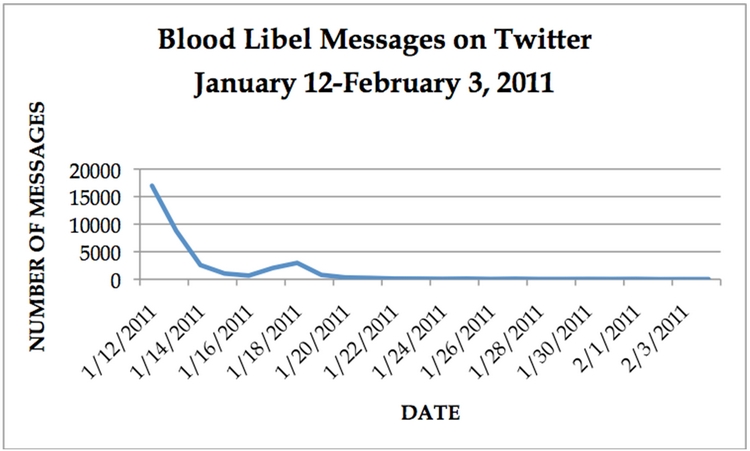 |
The message stream drops precipitiously after two or three days, with a spike in message volume on January 17 and 18, after Palin defended herself on FOX News the evening of January 16.
The Blood LIbel Stream: Who
Sarah Palin’s use of the term “blood libel” in a Facebook posting on January 12, 2011 defending herself against the charge that her overheated and violent rhetoric had contributed to the shooting rampage in Tuscon, Arizona created a flash flood of messages on Twitter. By February 4, 2011, some 21,593 usernames had sent a total of 35,940 tweets including the phrase “blood libel.”
The most prolific tweeter went by the username “bloodlibel,” and posted 544 messages, fully 1.5 percent of all tweets including the words “blood libel.” The next most prolific contributor was “SarahStormRpt,” posting 127 messages (.3 percent of the total) including “blood libel.” Only 10 users posted more than 50 messages; 291 users posted 10 or more messages. Of the total of more than 21,000 tweets, 5516 posted two or more messages; 16, 077 users (nearly 75 percent of the total) posted but a single message including the words “blood libel.”
While there were a huge number of users tweeting, 40.5 percent of the postings (16,615 messages) were “re-tweets,” where one user essentially “forwarded” the tweet of another user. Better than 50 percent of all tweets in the stream (21,016 messages) included an http link. Let us now turn to a closer examination of the substantive content of the blood libel message stream.
The Blood Libel Stream: What
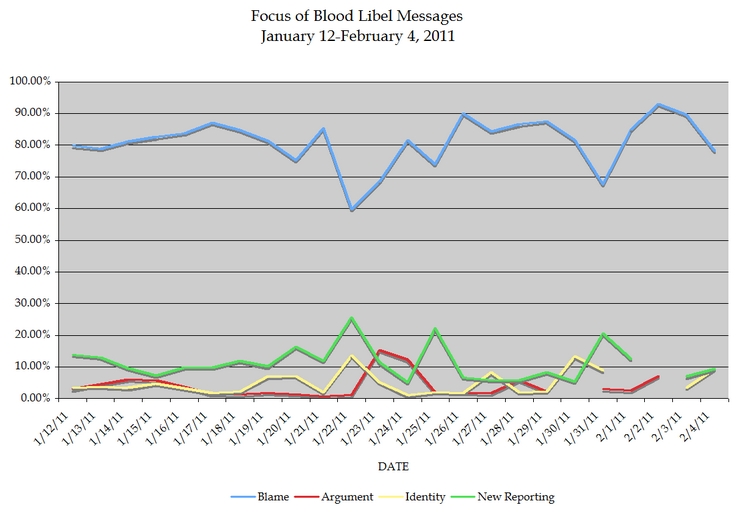 |
The vast majority of messages were focused on blame (including words like “Palin,” “Loughner,” “provocation,” “perpetrator,” and “rhetoric”). Typically over the course of this message stream, the next largest category of messages involve news reporting. Messages including words of identity (including “Giffords,” “Judge,” and “Taylor Green”) are, on most days, next most common. Words of argument or division, while typically least common among the four categories, do rise on occasion as a percentage of all messages, including a spike on Sunday January 23, a point by which mainstream media coverage had solidified and Palin’s responses had come under widespread criticism including from some in her own party (see for example Washington 2011; Mann 2011). Note, however, the sharp rise in pro-Palin language on January 23 and 24.
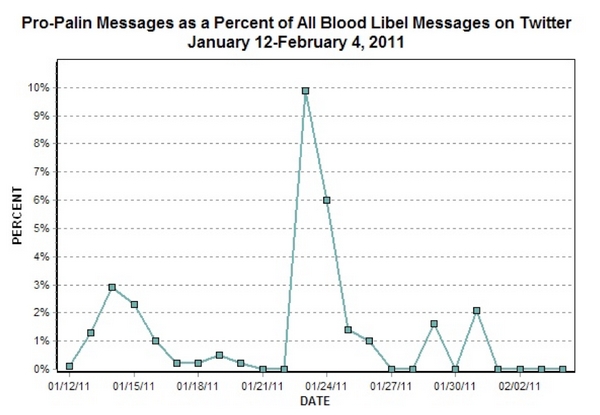 |
We can drill deeper into the substance of the stream of twitter messages including the phrase blood libel by examining the most commonly repeated phrases. While there are some serious limitations to substantive analysis of tens of thousands of data points, we can use content analysis software to identify the most commonly appearing phrases. On the first day of the stream (January 12) there were in excess of 15,000 messages. Because oft repeated phrases may differ slightly, several separate entries may in fact represent the same phrase being repeated. A cursory examination of the most commonly appearing phrases indicate that most of the messages frequently re-tweeted were critical of Sarah Palin. The most repeated tweet appears to be the following: “When asked to use ‘blood libel’ in a sentence, Palin said, ‘when you hunt a moose, blood libel to pour out of it.” That message, originally posted by BorowitzReport, appeared in at least 5.3 percent of cases on January 12. The next most commonly appearing phrases occurred in fewer than 1.5 percent of cases. They include “Palin need better advice before she issues statements” (1.4 percent of cases), “Sorry in advance for whatever Sarah Palin has to say about MLK Day” (1.3 percent of cases), “Pat Buchanan calls Palin’s blood libel remark ‘excellent.’ That’s like getting a dog show blue ribbon from Michael Vick” (1 percent of cases), and “Calling bad press a blood libel is like calling a rough day at work the holocaust” (.8 percent of cases). At least one fairly common re-tweet was supportive of Sarah Palin. The user “RabbiShmuley” posted “sarah palin or any person falsely accused of being accessory 2 murder has right to call it ‘blood libel.’ Not reserved only 4 accusing jews.”
On January 13, the second day of the blood libel stream, the number of pro-Palin messages as a share of the total stream appears to increase. While the most commonly re-tweeted message continued to be BorowitzReport’s moose tweet (1.9 percent of cases), the next most commonly appearing phrase was “Palin is right about blood libel” appearing in 1.3 percent of cases. In order, the next most common re-tweets include “why Sarah Palin used the term blood libel” (1.0 percent of cases), “Term ‘blood libel’ used on MSNBC in 2000 in Reference to Bush, In 2006 to Kerry Without Objection by Network Hosts” (.8 percent of cases), “Top 10 Reasons to Stop the Blood Libel Schmear Campaign against Honorary Jew Sarah Palin … ” (.8 percent of cases). The most commonly appearing phrases on January 14 also suggest a trend toward messages more supportive of Palin, though the most commonly re-tweeted message included a html link to a blog from The Economist magazine website (appearing in just over 2 percent of cases). On January 15, the top tweet read, “the same people who have a problem with the term ‘blood libel’ also have a problem with ‘In God We Trust.’ Take it for what its worth” (1.6 percent of cases). Other top tweets also were pro-Palin, including “@SpeakerBoehner I would ask you not to go soft on the Left after their attempted blood libel this week. Go on offense and let them have it” (.6 percent of cases). On January 16, the top tweet was “Sharpton is a real practitioner of violent speech and blood libel” (2.8 percent of cases). The tweet “apologizing in advance for whatever Sarah Palin has to say about MLK Day” re-appeared among the most commonly re-tweeted messages (.9 percent). On January 17, the day after Palin’s FOX News interview, the most commonly re-tweeted message was “Gave a toast at my friend’s wedding last night. ‘Blood libel’ line did not get the laugh I was hoping for” (5.0 percent of cases). The next most commonly re-tweeted messages were supportive of Palin, including “Palin says her use of ‘blood libel’ after Tucson was appropriate and that she knows the history of the term with Jews” (3.4 percent of cases). Over the next several days, the pattern persists. The volume of the message stream declines, and over time, the share of pro-Palin messages rises.
The Blood Libel Stream: Where
Of all messages in the blood libel stream, 24.4 percent included a hashtag (the # symbol followed by a name or topic of interest). The hashtag that appeared most frequently was “TCOT” (Top Conservatives on Twitter), which constituted 12.2 percent of hashtags. Next most common was “P2,” a progressive counterpart to TCOT comprising 8.9 percent of hashtags. The table below documents the 30 most frequently appearing hashtags over the life of the stream.
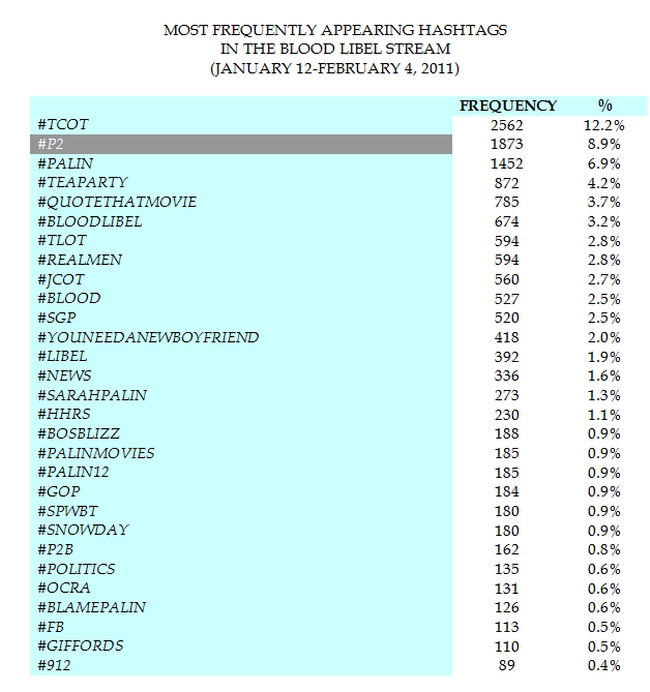 |
Roughly 50 percent of all hashtags referred to the top twelve hashtags. The figure below charts the top seven hashtags overall by date over the life of the blood libel stream.
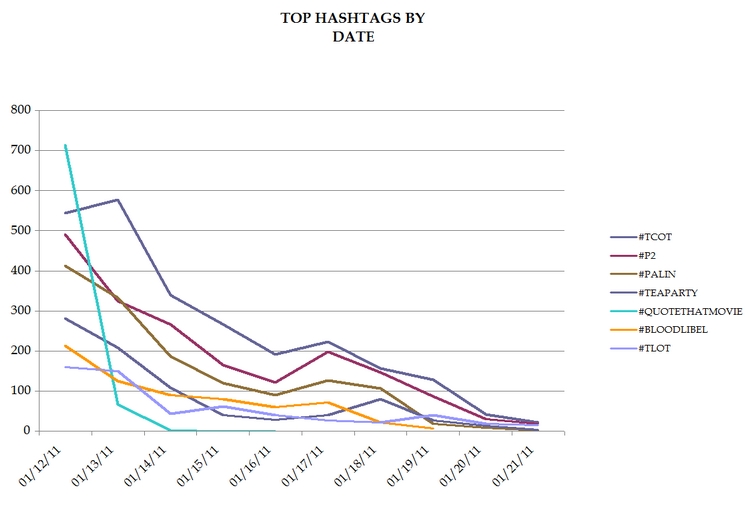 |
The chart indicates that in general, hashtag references tend to track a similar arc. Notably, however, the hashtag “quotethatmovie” bursts like a supernova only to disappear completely; these tweets do not appear to be related to Sarah Palin’s Facebook posting but were included in the stream because they also included the hashtags “#blood” and/or “#libel.” It is perhaps significant to note the divergent trends in #TCOT and #P2 use during the second day of the stream. This appears to underscore the rally effect for Palin following her remarks.
The Blood Libel Stream: Why?
It is hard to review the blood libel twitter stream and not suspect that it represented a conscious effort on the part of the former Alaska Governor and 2008 GOP vice-presidential nominee. One portrait readily sketched is consistent with the victimization narrative of Sarah Palin, and it reveals the dramatic impact the FOX News pundit’s words had. Division, in short, appeared to suit Palin, as it fired her supporters and reinforced her status as victim at the hands of what she frequently refers to as the “lamestream media.”
Another Palin pattern is hard to ignore: spotlight stealing. Palin managed to draw prominent media attention on the days putative rivals Mitt Romney and Michelle Bachmann announced their presidential campaigns.
The Language of Threat in our Political Discourse
A member of congress was shot and hundreds of thousands of Twitter messages sought the answer to what had happened, how did it happen, and what were the implications for the political system.
A first move was to associate the action with terrorism. Terrorism has been the fundamental threat for the society for a decade. Bringing this act into the domain of terrorism sets up a whole series of understandings. Stereotypes abound in the common cultural understanding of terrorism, and one came to the fore in this case. It was argued in thousands of Twitter messages that terrorism cannot mean muslim even though that is one of the stereotypes. So, they fought it out with CNN's interpretation that Loughner was not a terrorist.
The second move was to assert that the how was Palin's campaign rhetoric for the 2010 congressional election. Crosshairs, targets, the slogan don't retreat, reload all produce a rhetorical context for the election that threatens to end up with crazies taking the language literally. So, the claim -- language matters. Language has consequences. Scrubbing your website of the offending language does not absolve you.
The third move was blood libel. An ancient story was invoked as a rhetorical device to claim that she, Palin, was being falsely accused and persecuted as Jews were accused and persecuted in the middle ages. Her accusation was met with a maelstrom of objections to the use of a sacred story to cover what she had done.
And after three weeks it was but a memory. The streams of communication that had converged now diverged. Representative Giffords had become a person of note. Between February and her return to the House of Representatives in August there were many thousands of Twitter messages about her health. Her health, her travels were subjects of interest, and Twitter was a way to keep track and satisfy that interest. And the pursuit of will she or won't she for Palin motivates an average of six to ten thousand messages a day along with occassional spikes into the tens of thousands.